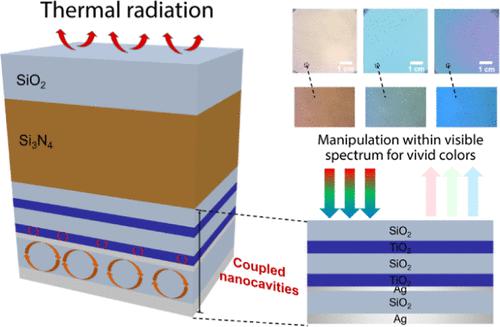当前位置:
X-MOL 学术
›
ACS Appl. Mater. Interfaces
›
论文详情
Our official English website, www.x-mol.net, welcomes your
feedback! (Note: you will need to create a separate account there.)
Daytime Sub-Ambient Radiative Cooling with Vivid Structural Colors Mediated by Coupled Nanocavities
ACS Applied Materials & Interfaces ( IF 8.3 ) Pub Date : 2022-12-01 , DOI: 10.1021/acsami.2c15573 Shenghao Jin 1 , Ming Xiao 2 , Wenbin Zhang 1 , Boxiang Wang 1 , Changying Zhao 1
ACS Applied Materials & Interfaces ( IF 8.3 ) Pub Date : 2022-12-01 , DOI: 10.1021/acsami.2c15573 Shenghao Jin 1 , Ming Xiao 2 , Wenbin Zhang 1 , Boxiang Wang 1 , Changying Zhao 1
Affiliation

|
Daytime radiative cooling is a promising passive cooling technology for combating global warming. Existing daytime radiative coolers usually show whitish colors due to their high broadband solar reflectivity, which is not suitable for aesthetic demands and effective display. It is challenging to produce high-cooling performance materials with vivid colors because colors are often produced by the absorption of visible light, decreasing net cooling power. In this work, we design a series of colorful multilayered radiative coolers (CMRCs) consisting of an optimized selective emitter for cooling and coupled nanocavities for structural coloration, which can successfully delicately balance the trade-off between the chromaticity and cooling performance. By judiciously designing the geometric parameters and manipulating the coupling effect inside the coupled nanocavities, our coolers show sub-ambient cooling performance and a larger color gamut (occupying 17.7% sRGB area) than reported ones. We further fabricate CMRCs and demonstrate that they have temperature drops of 3.4–4.4 °C on average based on outdoor experiments. These CMRCs are promising in thermal management of electronic/optoelectronic devices and outdoor facilities.
中文翻译:

耦合纳米腔介导的具有生动结构颜色的日间亚环境辐射冷却
日间辐射冷却是一种很有前途的被动冷却技术,可用于应对全球变暖。现有的日间辐射冷却器由于其宽带太阳反射率高,通常呈现发白的颜色,不适合美学需求和有效显示。生产具有鲜艳颜色的高冷却性能材料具有挑战性,因为颜色通常是通过吸收可见光产生的,从而降低了净冷却功率。在这项工作中,我们设计了一系列彩色多层辐射冷却器 (CMRC),包括用于冷却的优化选择性发射器和用于结构着色的耦合纳米腔,可以成功地微妙地平衡色度和冷却性能之间的权衡。通过明智地设计几何参数和操纵耦合纳米腔内的耦合效应,我们的冷却器显示出低于环境的冷却性能和比报道的更大的色域(占据 17.7% sRGB 区域)。我们进一步制造了 CMRC,并证明根据室外实验,它们的平均温度下降了 3.4–4.4 °C。这些 CMRC 在电子/光电设备和户外设施的热管理方面很有前途。
更新日期:2022-12-01
中文翻译:

耦合纳米腔介导的具有生动结构颜色的日间亚环境辐射冷却
日间辐射冷却是一种很有前途的被动冷却技术,可用于应对全球变暖。现有的日间辐射冷却器由于其宽带太阳反射率高,通常呈现发白的颜色,不适合美学需求和有效显示。生产具有鲜艳颜色的高冷却性能材料具有挑战性,因为颜色通常是通过吸收可见光产生的,从而降低了净冷却功率。在这项工作中,我们设计了一系列彩色多层辐射冷却器 (CMRC),包括用于冷却的优化选择性发射器和用于结构着色的耦合纳米腔,可以成功地微妙地平衡色度和冷却性能之间的权衡。通过明智地设计几何参数和操纵耦合纳米腔内的耦合效应,我们的冷却器显示出低于环境的冷却性能和比报道的更大的色域(占据 17.7% sRGB 区域)。我们进一步制造了 CMRC,并证明根据室外实验,它们的平均温度下降了 3.4–4.4 °C。这些 CMRC 在电子/光电设备和户外设施的热管理方面很有前途。











































 京公网安备 11010802027423号
京公网安备 11010802027423号